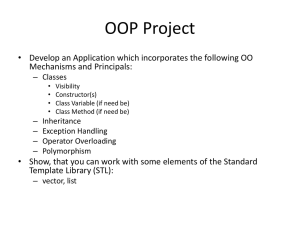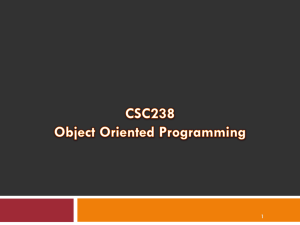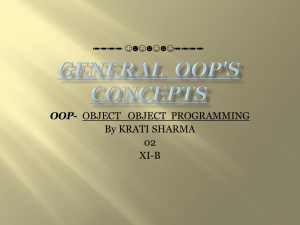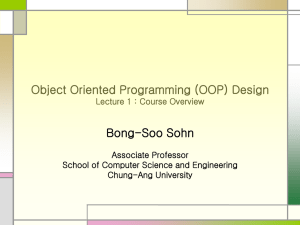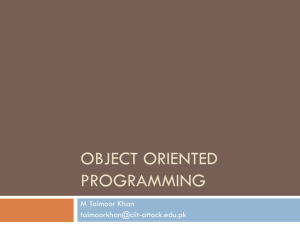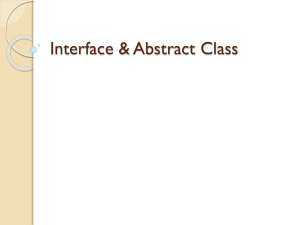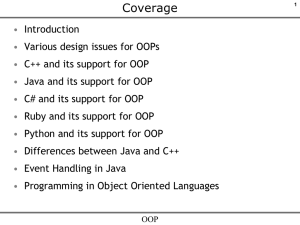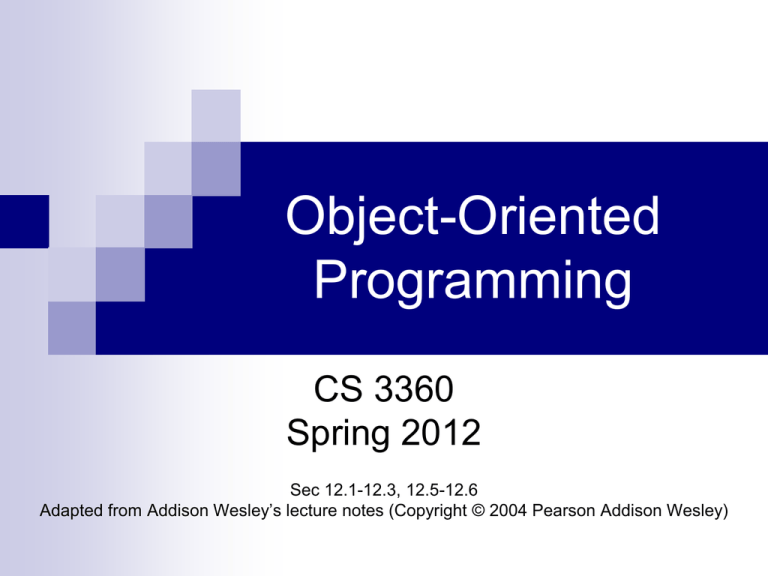
Object-Oriented
Programming
CS 3360
Spring 2012
Sec 12.1-12.3, 12.5-12.6
Adapted from Addison Wesley’s lecture notes (Copyright © 2004 Pearson Addison Wesley)
Outline
Basics of object-oriented programming
Design issues for OO languages
Support for OOP in C++
Support for OOP in Java
Implementation of OO constructs
2
Object-Oriented Programming
Paradigm evolution
1. Procedural: 1950s-1970s (procedural
abstraction)
2. Data-oriented: early 1980s (data abstraction)
3. OOP: late 1980s (inheritance and dynamic
binding)
Support for reuse and hierarchical organization
3
Categories of OOPLs
1. Pure OOP languages
Smalltalk
2. Extension to existing language
C++ (procedural and data-oriented)
Ada 95 (procedural and data-oriented)
CLOS (functional programming)
4
Categories (Cont.)
3. New imperative with OO support
Eiffel
Java
(based on C++)
C# (based on Java)
5
Definitions of OOP
ADTs are called classes.
Class instances are called objects.
A class that inherits is a derived class or a
subclass.
The class from which another class inherits is a
parent class or superclass.
Subprograms that define operations on objects
are called methods.
6
Definitions of OOP (Cont.)
Calls to methods are called messages.
The entire collection of methods of an object is
called its message protocol or message
interface.
Messages have two parts--a method name and
the destination object (receiver).
In the simplest case, a class inherits all of the
entities of its parent.
7
Inheritance
Inheritance can be complicated by access controls to encapsulated
entities.
Besides inheriting methods as is, a class can modify an inherited
method.
A class can hide entities from its subclasses.
A class can hide entities from its clients.
A class can also hide entities for its clients while allowing its subclasses
to see them.
The new one overrides the inherited one.
The method in the parent is overridden.
Single vs. Multiple Inheritance
One disadvantage of inheritance for reuse:
Creates interdependencies among classes that complicate
maintenance
8
Variables of Class
There are two kinds of variables in a class:
1. Class variables - one/class
2. Instance variables - one/object
There are two kinds of methods in a class:
1. Class methods – accept messages to the class
2. Instance methods – accept messages to objects
9
Polymorphism
A polymorphic variable can be defined in a class that is able to
reference (or point to) objects of the class and objects of any of its
descendants.
When a class hierarchy includes classes that override methods and
such methods are called through a polymorphic variable, the binding
to the correct method MUST be dynamic.
This polymorphism simplifies the addition of new methods.
10
Abstract Methods and Classes
An abstract method is one that does not
include a definition (it only defines a
protocol).
An abstract class is one that includes at
least one abstract method.
An abstract class cannot be instantiated.
11
Outline
Basics of object-oriented programming
Design issues for OO languages
Support for OOP in C++
Support for OOP in Java
Implementation of OO constructs
12
Design Issues for OOP
D1: Exclusivity of Objects
D2. Are subclasses subtypes?
D3. Implementation and Interface
Inheritance
D4. Type Checking and Polymorphism
D5. Single and Multiple Inheritance
D6. Allocation and De-allocation of Objects
D7. Dynamic and Static Binding
13
Design Issues
D1: Exclusivity of Objects
a. Everything is an object
Advantage
- elegance and purity uniformity
Disadvantage - slow operations on simple objects
(e.g., float)
b. Add objects to an imperative typing system
Advantage
- fast operations on simple objects
Disadvantage - results in a confusing type system
(two kinds of entities)
14
D1: Exclusivity of Objects (cont’d)
c. Include an imperative-style typing system for
primitives but make everything else objects
Advantage
- fast operations on simple objects and a
relatively small typing system
Disadvantage - still some confusion because of the
two type systems
15
Design Issues (cont’d)
D2. Are subclasses subtypes?
an “is-a” relationship hold between a
parent class object and an object of the
subclass?
Does
16
Design Issues (Cont.)
D2. Are subclasses subtypes?
an “is-a” relationship hold between a
parent class object and an object of the
subclass?
Subclasses are not subtypes!
See extra-credit assignment: due Tuesday
February, 14.
Does
17
Design Issues (cont’d)
D3. Implementation and Interface Inheritance
If
only the interface of the parent class is visible to the
subclass, it is interface inheritance
Disadvantage - can result in inefficiencies
If both the interface and the implementation of the
parent class is visible to the subclass, it is
implementation inheritance
Disadvantage - changes to the parent class require
recompilation of subclasses, and sometimes even
modification of subclasses
18
D3. Implementation and
Interface Inheritance (cont’d)
The problems caused by multiple inheritance of classes result from
potential conflicts among the various implementations of common
methods in the inheritance chain.
But suppose you knew that the classes you were inheriting from were
pure abstract classes with no implementation?
In that case, multiple-inheritance wouldn't cause any problems
because there would be no implementations to cause conflicts.
This is what interfaces provide: a way to inherit just a set of
method and property specifications with no implementation to worry
about and no problem inheriting from as many interfaces as you need.
19
Design Issues (cont’d)
D4. Type Checking and Polymorphism
Polymorphism
may require dynamic type checking of
parameters and the return value.
Dynamic type checking is costly and delays error
detection.
If overriding methods are restricted to having the
same parameter types and return type, the checking
can be static.
20
Design Issues (cont’d)
D5. Single and Multiple Inheritance
Disadvantages
of multiple inheritance:
Language and implementation complexity (in part
due to name collisions)
Potential inefficiency - dynamic binding costs more
with multiple inheritance (but not much)
Advantage:
Sometimes it is extremely convenient and valuable
21
Design Issues (cont’d)
D6. Allocation and deallocation of objects
From
where are objects allocated?
If they all live in the heap, references to them are
uniform
Simplifies assignment - dereferencing can be
implicit
Is deallocation explicit or implicit?
22
Design Issues (cont’d)
D6. Allocation and deallocation of objects
From
where are objects allocated?
If they all live in the heap, references to them are
uniform
Simplifies assignment - dereferencing can be
implicit
Is deallocation explicit or implicit?
In C++ it is
In Java it is not (garbage collector)
Other differences exist between the memory models of the
two languages
23
Design Issues (Cont.)
D7. Dynamic and static binding
Should
ALL binding of messages to methods be
dynamic?
If none are, you lose the advantages of dynamic
binding
If all are, it is inefficient
24
Design Issues (Cont.)
D7. Dynamic and static binding
Should
ALL binding of messages to methods be
dynamic?
If none are, you lose the advantages of dynamic
binding
If all are, it is inefficient
No clear answer to that, except that when using
polymorphism and overridden methods, static binding
will not always be able to detect errors
25
Outline
Basics of object-oriented programming
Design issues for OO languages
Support for OOP in C++
Support for OOP in Java
Implementation of OO constructs
26
Group activities: Jigsaw!
40 students
Division of the topics between:
Support
for OOP in C++
Support for OOP in Java & Implementation of
OOP constructs
20 students in each: 5 teams of 4
Count
1-10
1-5: topic 1
6-10: topic 2
27
Group activities: Jigsaw!
Objectives
In each team:
One
gatekeeper and all notekeepers
Objectives:
Understand
your own topic
Design a short presentation of it intended to
your classmates and me
Make sure to include examples to illustrate
each point
28
Group activities: Jigsaw!
How?
The rest of today’s session
On Thursday:
Quiz
on your own topic
Work in recomposed teams
(2 topics per team)
On Tuesday:
Quiz
on both topics
29
Support for OOP in C++
General characteristics:
Mixed
typing system
Constructors and destructors
Elaborate access controls to class entities
30
Support for OOP in C++
Inheritance
A
class need not be the subclass of any class
Access controls for members are
1. Private (visible only in the class and friends)
(disallows subclasses from being subtypes)
2. Public (visible in subclasses and clients)
3. Protected (visible in the class and in subclasses, but
not clients)
31
Support for OOP in C++
Inheritance (continued)
In
addition, the subclassing process can be declared
with access controls (private or public), which define
potential changes in access by subclasses
a. Private derivation - inherited public and protected
members are private in the subclasses
b. Public derivation - public and protected members are
also public and protected in subclasses
32
Example
class base_class {
private:
int a;
float x;
protected:
int b;
float y;
public:
int c;
float z;
};
class subclass_1 : public base_class { … };
// - b and y are protected and c and z are public
class subclass_2 : private base_class { … };
// - b, y, c, and z are private, and no derived
//
class has access to any member of base_class
33
Support for OOP in C++
Reexportation
A
member that is not accessible in a subclass
(because of private derivation) can be declared to be
visible there using the scope resolution operator (::),
e.g.,
class subclass_3 : private base_class {
base_class :: c;
…
}
34
Support for OOP in C++
Reexportation (continued)
One
motivation for using private derivation:
A class provides members that must be visible, so
they are defined to be public members; a derived
class adds some new members, but does not want
its clients to see the members of the parent class,
even though they had to be public in the parent
class definition
35
Support for OOP in C++
Multiple inheritance is supported
If
there are two inherited members with the same
name, they can both be referenced using the scope
resolution operator (::)
36
Support for OOP in C++
Dynamic binding
A
method can be defined to be virtual, which means
that they can be called through polymorphic variables
and dynamically bound to messages
A pure virtual function has no definition at all
A class that has at least one pure virtual function is an
abstract class
37
Support for OOP in C++
Evaluation
C++
provides extensive access control (unlike
Smalltalk)
C++ provides multiple inheritance
In C++, the programmer must decide at design time
which methods will be statically bound and which
must be dynamically bound
Static binding is faster!
Smalltalk type checking is dynamic (flexible, but
somewhat unsafe)
Because of interpretation and dynamic binding,
Smalltalk is ~10 times slower than C++
38
Outline
Basics of object-oriented programming
Design issues for OO languages
Support for OOP in C++
Support for OOP in Java
Implementation of OO constructs
39
Support for OOP in Java
Because of its close relationship to C++, we
focus on the differences from that language
General Characteristics
All
data are objects except for the primitive types
All primitive types have wrapper classes that store
one data value
All objects are heap-dynamic, are referenced through
reference variables, and most are allocated with new
40
Support for OOP in Java
Inheritance
Single
inheritance only, but there is an abstract class
category that provides some of the benefits of
multiple inheritance (interface)
An
interface can include only method declarations
and named constants, e.g.,
public class Clock extends Applet
implements Runnable { … }
Methods can be final.
41
Support for OOP in Java
Dynamic binding
In
Java, all messages are dynamically bound to
methods, unless the method is final (means it
cannot be overridden; therefore, dynamic binding
serves no purpose)
42
Support for OOP in Java
Encapsulation
Two
constructs, classes and packages
Packages provide a container for classes that are
related (can be named or unamed)
Entities defined without a scope (access) modifier
have package scope, which makes them visible
throughout the package in which they are defined they go in the unnamed package
Every class in a package is a friend to the package
scope entities elsewhere in the package
So, package scope is an alternative to the friends
of C++
43
Outline
Basics of object-oriented programming
Design issues for OO languages
Support for OOP in C++
Support for OOP in Java
Implementation of OO constructs
44
Implementing OO Constructs
Storage structure of instance variables
Class
instance records (CIRs) store the state of an
object
The CIR for a subclass adds its new fields to the
parent CIR.
Dynamic bindings of messages to methods
Virtual
Method Tables (VMTs) are used for dynamic
binding.
45
Dynamic Binding (Dispatch)
class Point {
private int x, y;
public Point(int x, int y) { this.x = x; this.y = y; }
public int getX() { return x; }
public int getY() { return y; }
}
class ColoredPoint extends Point {
private Color color;
public ColoredPoint(int x, int y, Color c) {
super(x, y);
color = c;
}
public Color getColor() { return color; }
}
CIR for Point
x
y
…
CIR for ColoredPoint
x
y
color
…
46
Dynamic Binding (Cont.)
ColoredPoint p
= new ColoredPoint(10,20,Color.RED);
p.getColor();
p.getX();
Point.class
super:
vmt:
…
p: class:
x: 10
y: 20
color:
ColoredPoint.class
super:
vmt:
…
Object.class
super:
vmt:
…
getX:
getY:
…
getColor:
…
Color.RED
47

